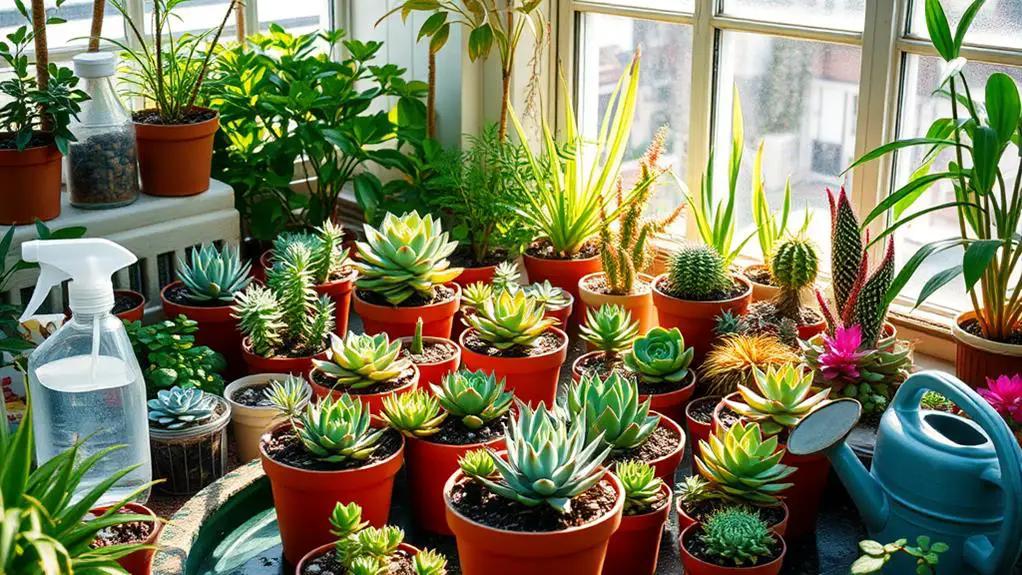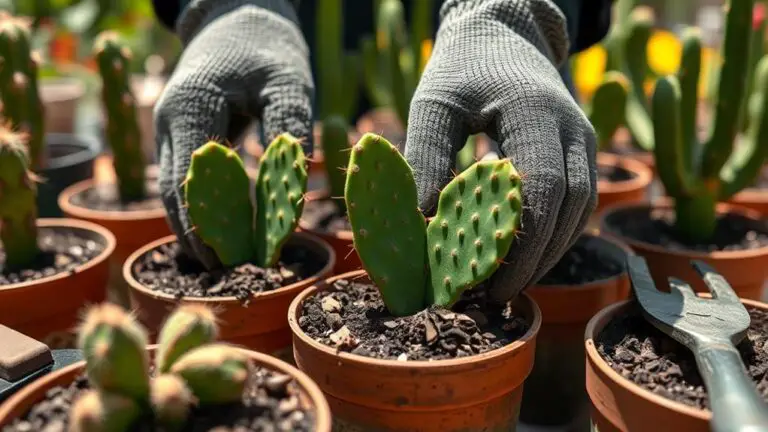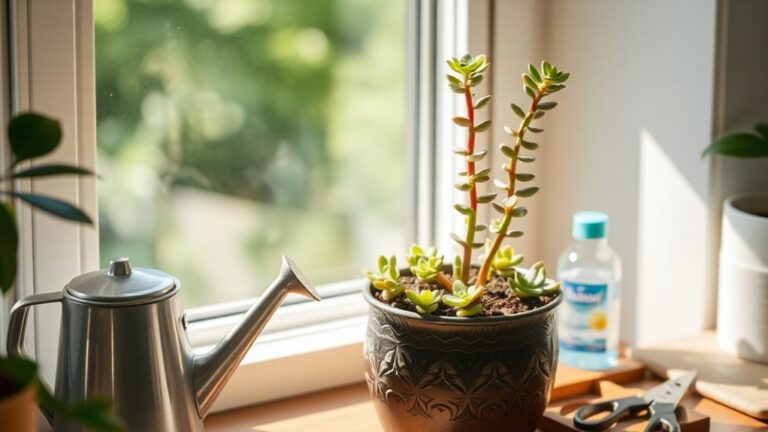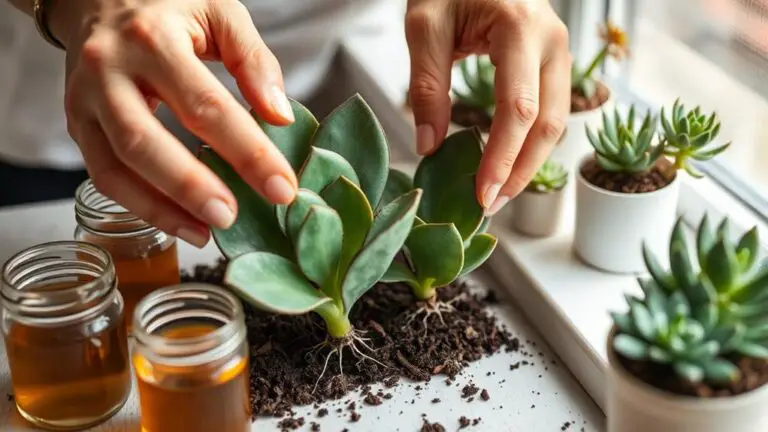7 Tips to Help Succulents Grow Faster
If you're looking to boost the growth rate of your succulents, there are several key practices you should adopt. By ensuring your plants get the right amount of light and maintaining ideal temperature conditions, you'll set a solid foundation. But that's just the beginning. Effective watering techniques and strategic fertilization can make a significant difference in their health and growth speed. Additionally, the choice of pot and regular care routines play vital roles. Curious about the specifics and how each tip can be implemented for maximum effect? Let's explore these strategies in more detail.
Succulent Growth Rate
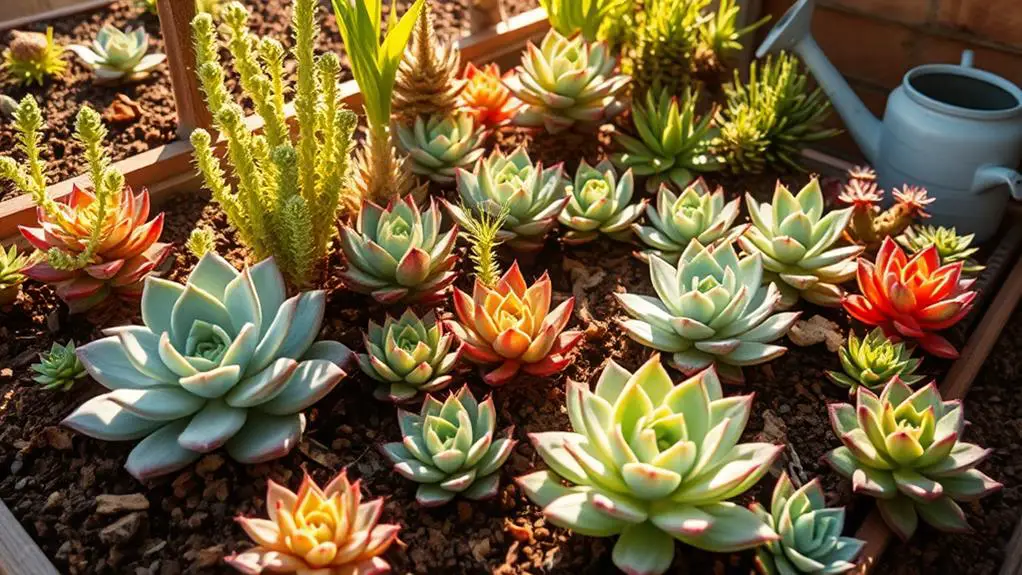
Succulent growth rates can vary considerably depending on the species and environmental conditions. You'll find that succulents like Echeverias, Kalanchoes, and Aloe Vera can grow much faster than others if you provide the right care.
The growing season for most succulents is in spring and summer, when they actively grow, while winter is their dormant phase, slowing their growth.
Sunlight exposure is essential for fast growth. Make sure your succulents get plenty of bright, indirect light to thrive. However, be cautious of harsh direct sunlight, which can cause damage.
Nutrients also play an important role. Use a well-balanced fertilizer during the growing season to give your plants the boost they need.
Regular maintenance, such as repotting, is fundamental. Repotting allows more room for roots to expand, promoting better growth. Additionally, removing offsets or pups helps the main plant focus its energy on growing stronger.
Environmental factors like temperature and humidity are significant too. Avoid extreme temperatures; neither freezing cold nor scorching heat is good for succulents.
With thoughtful care, you can help your succulents achieve a healthy and faster growth rate.
Ideal Growing Environment

Creating the ideal growing environment is vital for guaranteeing your succulents thrive. Start by maintaining the right temperature. Succulents grow best in a range of 65-80°F during their active growing season. Avoid exposing them to freezing temperatures, as cold can damage them.
Next, consider light. Your succulents need at least 6 hours of bright light daily to stay healthy. Without enough light, they might grow tall and thin, a condition called "leggy growth." If natural light is limited, especially in winter, use grow lamps to supplement it.
Humidity is another important factor. Keep humidity levels around 40%. Too much humidity can cause rot and diseases. Maintain good air circulation to help control humidity.
The soil you use is also significant. Choose well-draining soil to prevent water from sitting around the roots, which can lead to root rot. A mix designed for succulents is ideal.
Lastly, don't forget about water and nutrients. Water your succulents only when the soil is dry, and avoid over-watering. Use a balanced fertilizer sparingly to provide necessary nutrients.
Enhancing Root Development
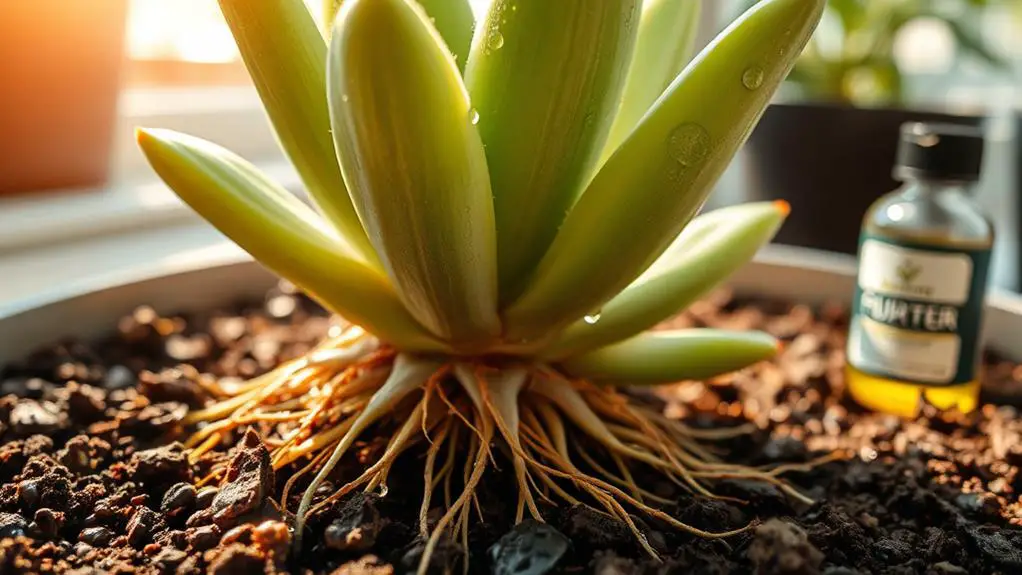
To help your succulents grow strong and healthy, regularly check and untangle their roots for better nutrient absorption and to prevent root binding.
Repotting them annually with fresh soil during the growing season supports their root expansion and overall health.
Also, choose a shallow, wide pot to allow roots to spread effectively and keep moisture levels in check.
Regular Root Maintenance
When it comes to guaranteeing your succulents thrive, regular root maintenance is key to enhancing root development and overall plant health. By paying attention to your plant's roots, you can improve nutrient absorption and promote faster succulent growth.
Here are some practical steps you can take:
- Check and Untangle Roots: Regularly inspect your succulent's roots and gently untangle them. This helps reduce root binding and allows for better root expansion.
- Use a Shallow, Wide Pot: Opt for a shallow, wide pot. It avoids excessive moisture retention while providing ample space for root development.
- Massage and Loosen Roots: Periodically spread the roots by gently massaging and loosening them. This encourages faster growth by maximizing nutrient uptake from the soil.
- Soil Aeration: Guarantee that the soil is aerated weekly to enhance oxygen levels. This supports robust root health and overall succulent growth.
Healthy root systems are crucial for your succulents. By focusing on root maintenance, you give your plants the best chance to thrive.
Annual Repotting Practices
Annual repotting practices can significantly boost the health and growth of your succulents. By repotting them annually during the growing season, you prevent root binding, which allows for better nutrient absorption and overall plant vigor.
When you repot, make sure to use fresh, well-draining soil. This supports root expansion and enhances the health of your succulents.
Choose a shallow, wide pot for your succulents. This type of pot minimizes moisture retention, promoting healthier root development.
When repotting, it's important to check and untangle the roots. This practice encourages a robust root system that supports faster growth.
Additionally, repotting provides an opportunity to remove offsets. Offsets are small offshoots that grow from the main plant. By removing these, you reduce competition for nutrients, allowing the main plant to thrive.
Soil and Drainage

Ensuring proper soil and drainage is fundamental for the health and growth of your succulents. Using a well-draining soil mix that includes coarse sand, perlite, and fine gravel helps prevent waterlogging and supports healthy root growth. This special mix provides the right water balance and allows for important nutrients to reach the roots.
To enhance airflow and reduce moisture retention, select pots made from terracotta or ceramic with drainage holes. These materials naturally absorb excess moisture, keeping the root environment balanced.
Regularly aerate the soil to improve oxygen levels, which is essential for root health and overall plant vigor. Monitoring soil moisture levels closely is key. Water your succulents only when the top 2-3 inches of soil are dry to avoid over-saturation, which can lead to root rot.
Here are some practical tips:
- Use a well-draining soil mix: Incorporate coarse sand, perlite, and fine gravel.
- Choose the right pot: Terracotta or ceramic pots with drainage holes are ideal.
- Aerate the soil: This improves oxygen levels for healthier roots.
- Monitor moisture levels: Water only when the top 2-3 inches are dry.
Consider adding pumice or worm castings to the soil mix to improve drainage and provide important nutrients for faster growth. By following these steps, you'll help your succulents thrive.
Managing Offsets and Blooms
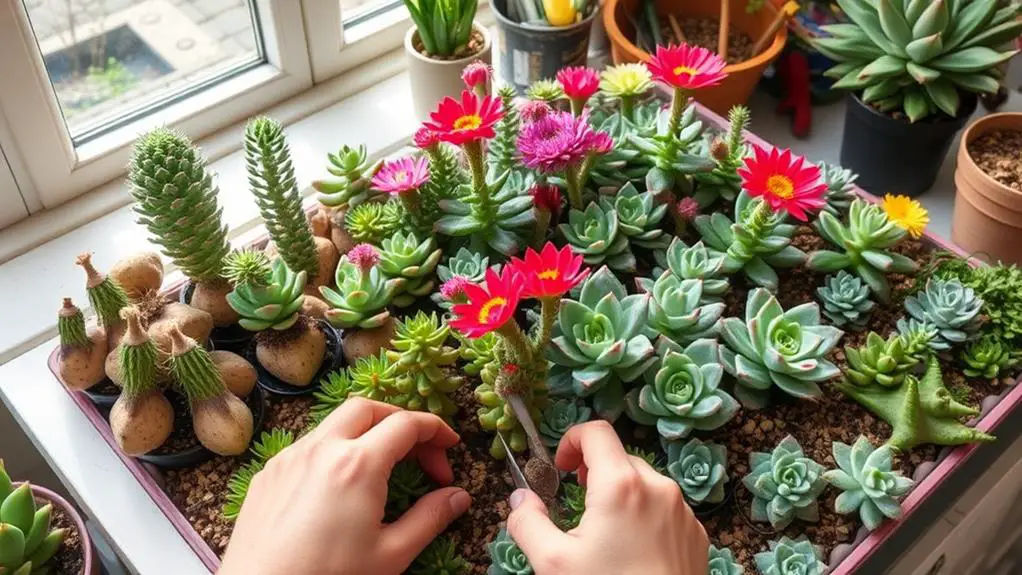
After establishing a healthy soil and drainage system, it's important to manage offsets and blooms to keep your succulents thriving.
Managing offsets is key because they compete for nutrients with the mother plant. By regularly removing them, you promote healthier growth for both the parent and the babies. When you separate offsets while they're still young, they adapt quickly to new environments and can thrive independently.
Regular maintenance of offsets is crucial to prevent overcrowding in pots. Overcrowding can hinder the overall growth rates of all your succulents. By giving each plant enough space, you can guarantee a more robust root system, which enhances the growth potential of each succulent.
Monitoring blooms is just as important. Blooming consumes a lot of energy from succulents. By snipping off flowers, you can redirect resources back to vegetative growth. This helps your succulents grow stronger and healthier.
Watering and Fertilization
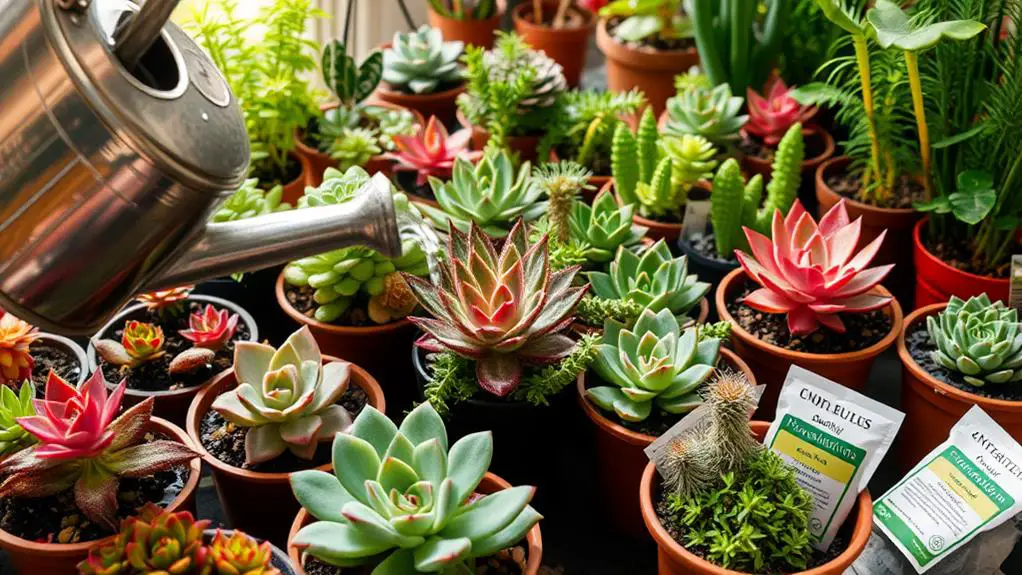
When it comes to watering your succulents, make sure you only water them when the soil is completely dry, and let the water reach deep into the roots without getting the leaves wet.
During the growing season, fertilize your succulents a couple of times with a balanced, organic fertilizer to support healthy growth.
Always keep an eye on soil moisture to avoid overwatering, which can lead to root rot.
Optimal Watering Schedule
To keep your succulents thriving, it's vital to follow an ideal watering schedule that meets their unique needs. Each succulent's hydration is essential for its growth, especially during the growing season.
Water your succulents thoroughly when the top 2-3 inches of soil are completely dry. This guarantees that the water reaches deep into the root system for peak hydration.
Here are some key points to remember:
- Deep watering: Aim for water to penetrate 3-4 inches into the soil to encourage a healthy root system.
- Growing season: Typically, water your succulents every 1-2 weeks during this time and reduce frequency in the dormant winter period.
- Transplanting: Wait at least 2 days after transplanting before watering to allow the roots to heal and acclimate.
- Nutrients: Fertilize 2-3 times a year with a balanced organic fertilizer to support growth during the active growing season.
Balanced Fertilizer Application
Having established the importance of an ideal watering schedule, let's focus on the balanced application of fertilizer, which is equally important for the health and growth of your succulents.
To support peak growth, apply a balanced fertilizer specifically formulated for succulents 2-3 times a year during the growing season. This guarantees your plants get the essential nutrients they need without over-fertilizing.
Using Moo Poo manure tea is a fantastic option. Steep it in water for 24-36 hours, and it'll promote healthy root development.
Fertilization timing is vital. Aim to fertilize in spring, fall, and sometimes summer, aligning with your succulents' active growth periods. Before fertilizing, check the soil moisture levels. Make certain the soil is dry to prevent root stress and damage from excess nutrients.
Consider the size of the succulent when applying fertilizer. As your plant grows larger, increase the amount to meet its nutritional needs.
But remember, more isn't always better. Careful, balanced fertilizer application guarantees your succulents thrive.
Avoid Overwatering Risks**
Overwatering poses a significant risk to your succulents, often leading to root rot and rapid decline. To avoid this, you should always wait until the soil is completely dry before watering again.
Succulents thrive in a dry environment and can handle drought much better than they can excess moisture. Here's how you can guarantee your succulents stay healthy:
- Use well-draining soil: A mix that includes coarse sand and perlite will help prevent water retention and promote healthy root systems.
- Deep watering: Aim for a depth of 3-4 inches to provide adequate hydration without leaving the surface soil too wet.
- Monitor moisture levels: Make sure the soil is dry before you water again to prevent root rot.
- Careful fertilization: Apply fertilizer 2-3 times a year to enhance growth without overloading the plant with nutrients, especially if combined with excessive watering.
Ongoing Care and Observation
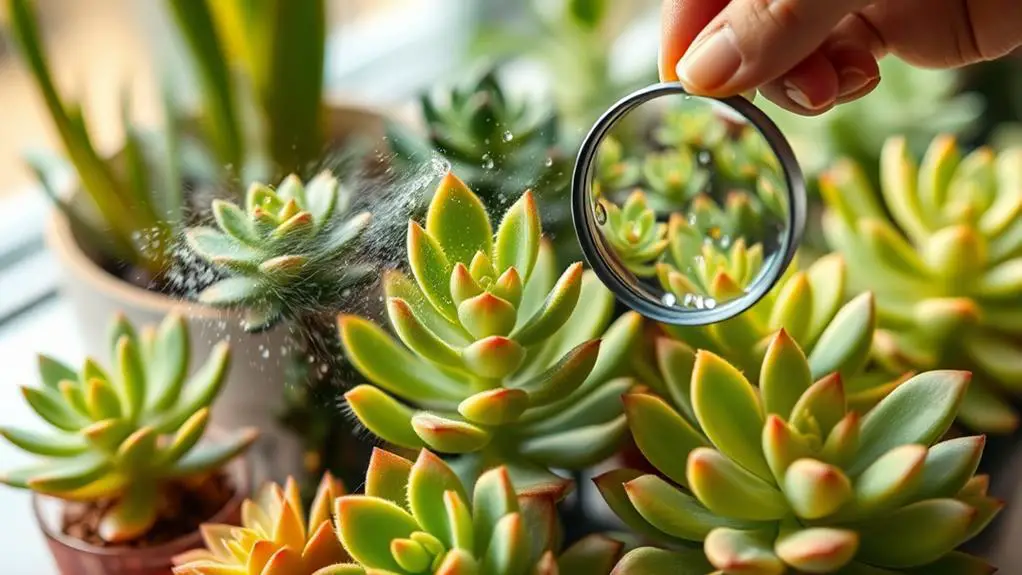
Consistently monitoring your succulents' light conditions is essential to their health, as they thrive with at least six hours of bright light daily.
It's important to check the light throughout the day and adjust your plants' positions if needed. This ongoing care helps guarantee they get the right amount of sunlight.
Tracking your succulents' growth progress with visual documentation, like photos and notes, can be very helpful.
This allows you to see what care techniques work best. Don't forget to remove any blooms promptly. Snipping flowering stems at the base redirects energy back into vegetative growth, helping your succulents grow stronger and healthier.
Pay attention to seasonal changes and adjust your watering and fertilization strategies accordingly.
In winter, you might need to water less, while in summer, they might need more moisture. Engaging with community feedback is a great way to learn.
Sharing experiences and tips with fellow succulent enthusiasts can offer valuable insights.
Frequently Asked Questions
How to Speed up Succulent Growth?
To speed up succulent growth, use well-draining soil and guarantee your pot has drainage holes. Water only when dry, provide 6 hours of indirect light daily, and fertilize once during the growing season with a balanced organic option.
Why Are My Succulents Growing so Slowly?
Your succulents might be growing slowly due to insufficient light, poor soil drainage, overwatering, extreme temperatures, or crowded pots. Make certain they get enough light, proper soil, and avoid temperature extremes to promote faster growth.
How to Make Succulents Thrive?
To make your succulents thrive, give them at least 6 hours of bright light daily, use a well-draining soil mix, water only when dry, fertilize 2-3 times a year, and repot annually in fresh soil.
Do Coffee Grounds Help Succulents Grow?
Yes, coffee grounds can help succulents grow. They enhance soil structure, provide essential nutrients, and improve drainage. Just use them sparingly to avoid mold and pests. Mixing them into the soil works best for balanced moisture retention.
Conclusion
By following these tips, you'll help your succulents grow faster and stay healthy. Remember, they love bright, indirect light and need just the right amount of water. Keep an eye on the temperature and make sure their soil drains well. Don't forget to fertilize during the growing season and choose the right pots. Regularly remove offsets and watch their progress. With a bit of care and attention, your succulents will thrive. Happy gardening!

